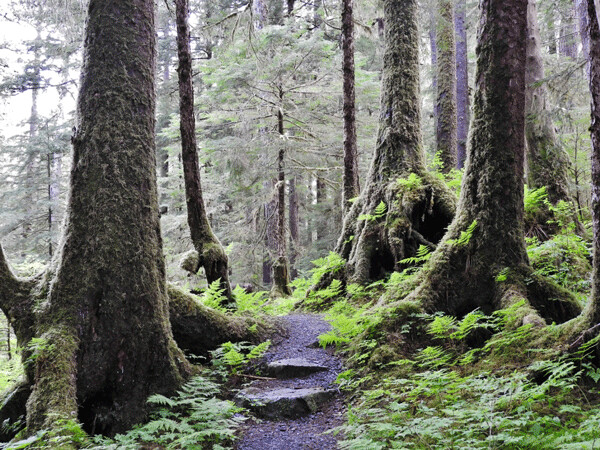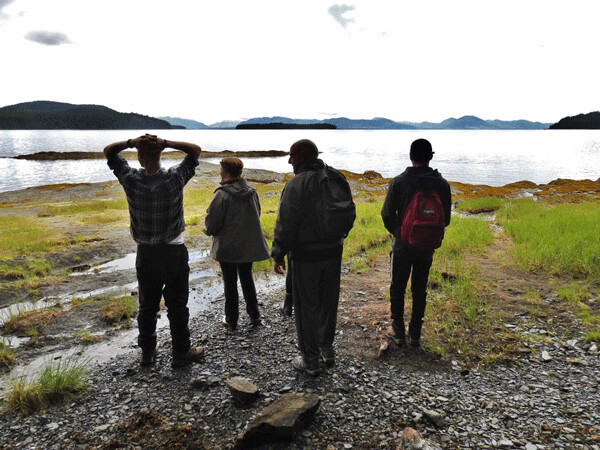Catching up to a Naturalist in Ketchikan


The Tongass Highway wound north out of the remote town of Ketchikan, Alaska. To my left, rocky beaches and protected coves showed themselves through a light mist. To my right, densely forested hills climbed out of sight into the fog. Just before the northern terminus of the Tongass Highway, I pulled into the small loop road of Settler’s Cove Campground.
First I took advantage of a break in the rain to set up my tent, and then I set out for a short wander down to the beach with my camera. The cove was a stunning mix of green marsh, gold seaweed, and angular rocks washed by a river flowing out of the forest. Layers of smoky hills faded into the distance. My wandering brought me back up to the park road, where a sign for waterfall viewing along a Lunch Falls Loop Trail caught my eye.

As I hiked through this temperate rainforest of huge trees and dripping moss, the faint odor of skunk perplexed me . . . until I realized that muddy spots along the trail were dominated by lush gardens of skunk cabbage. Faint voices wafting through the enormous trunks of Sitka spruce and western red cedars also puzzled me, until I came around a corner and spied an all-too-familiar sight: a group of hikers standing high and dry on the trail, while an energetic naturalist sank up to his rubber-booted ankles into a mud hole just beyond. Just a couple months ago I stepped off a trail into a snowdrift for a similar purpose.
The guy looked a little younger than me, and wore an Alaska-style uniform of a flannel shirt, rain pants, and waterproof boots. “I love talking about mud puddles,” he was saying as I approached. I’m not sure how his family of four clients felt about that statement, but I was intrigued. Noticing me, he motioned to the group to let me pass. “Or,” he added amicably, “you could tag along.” Not sure if he was serious, but too curious to be more polite, I replied, “I just might do that!”
Tim Hemme, as I later discovered was his name, guides E-bike and hiking trips for the Ketchikan Kayak Co. These small group tours are a nice alternative to bus tours for cruise ship visitors stopping in port. Tim is a self-taught naturalist, and started reading books like “The Nature of Southeast Alaska,” by Robert Armstrong (who I’ll tell you about next week) just for personal edification.
Although this Missouri native came to Ketchikan on a whim, without a job or a plan, Tim soon found work on a fishing boat in Sitka. That experience only lasted 24 hours. He flew in, the boat sank (it had a hole from being parked on a rock when the tide went out,) and he flew back to Ketchikan. Now he often tends the boat for commercial divers bringing in sea cucumbers (a delicacy in Asia) and geoducks (a species of clam) by the ton. When his friend opened the guide business, Tim agreed to help out.
Still standing in the puddle, Tim went on to explain that water-soaked soils, paired with the acidifying action of sphagnum mosses, create enormous patches of muskegs as you go inland from the coast. In these cold, acidic, oxygen-poor environments, the decomposition rate slows to almost nothing. In the Northwoods, of course, we call these bogs (or maybe poor fens if you want to get technical.)
On the other hand, the lush upland forest adjacent to his mud puddle (just the tip of a muskeg, he explained), exhibits an extraordinary rate of decomposition. The huge trunks of fallen trees are soon broken down into rich, brown sponges, and seedlings use them as nurse logs and nurse stumps to begin their tiny lives. Water-soaked lichens fall from the canopy and their decaying bodies return nitrogen to the soil. Muskeg vs temperate rain forest: these water-soaked neighbors have their differences.

As we climbed out of the small hollow, the twisted trunk of a giant tree caught someone’s eye. Tim explained that this was a western red cedar. The fibrous bark definitely reminded me of northern white cedars at home, and craning my neck I could see the cedar’s fans of lace-like needles silhouetted against the bright gray sky. The split-open trunk revealed the tree’s twisted grain. “Western red cedars are better than any other tree at withstanding high winds,” commented Tim. “Their spiraling grain allows them to load up the wind’s force like a screw, and then spring back. Load up; spring back. It prevents them from just falling over.”
We eventually popped out at the beach, and Tim stopped to stare thoughtfully across the ocean. “You have to know what you’re doing to take a boat through the passage,” he advised. “Irregular spires of shallow rocks mean that at high tide you’re fine, and at low tide you’re sunk.” Tim didn’t tell his clients the story about his first experience on a fishing boat, but clearly that was on his mind.
All too soon we reached the end of the Tongass Highway where the group’s E-bikes were parked. I thanked them for letting me tag along and turned back toward the woods. Skunk cabbage, cedars, bogs, and a naturalist: I was giddy from the combination of familiar friends and a spectacular new place.
Emily is in Alaska for the summer! Follow the journey in this column, and see additional stories and photos on her blog: http://cablemuseum.org/connect/.
For 50 years, the Cable Natural History Museum has served to connect you to the Northwoods. Come visit us in Cable, WI! Our new exhibit: “Bee Amazed!” is open.
